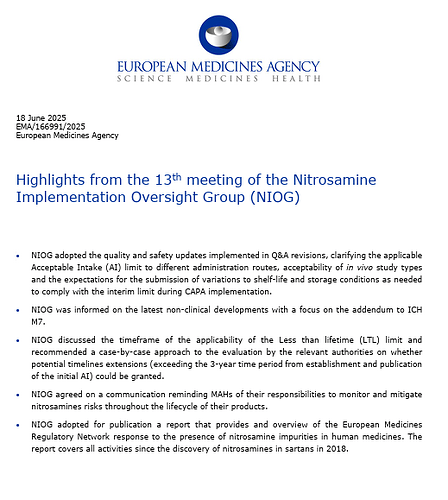- NIOG adopted the quality and safety updates implemented in Q&A revisions, clarifying the applicable Acceptable Intake (AI) limit to different administration routes, acceptability of in vivo study types and the expectations for the submission of variations to shelf-life and storage conditions as needed to comply with the interim limit during CAPA implementation.
- NIOG was informed on the latest non-clinical developments with a focus on the addendum to ICH M7.
- NIOG discussed the timeframe of the applicability of the Less than lifetime (LTL) limit and recommended a case-by-case approach to the evaluation by the relevant authorities on whether potential timelines extensions (exceeding the 3-year time period from establishment and publication of the initial AI) could be granted.
- NIOG agreed on a communication reminding MAHs of their responsibilities to monitor and mitigate nitrosamines risks throughout the lifecycle of their products.
- NIOG adopted for publication a report that provides and overview of the European Medicines Regulatory Network response to the presence of nitrosamine impurities in human medicines. The report covers all activities since the discovery of nitrosamines in sartans in 2018.
Nothing escapes your notice, dear Yosuke.
thank you for the speedy updates ![]()
You’re welcome, Eleni. ![]()
These contents appear to be included in the latest version (Rev. 22).
Clarifying applicable AI limit to different administration routes.
Have I missed something around different limits for different administration routes (e.g. topical) or is this just clarifying that the limits are the same for all routes?
The latter is probably the case. Relevant passage in the guidance: The same risk approach is applicable to all routes of administration. Corrections to limits are generally not acceptable.
The Q&A 10 change in Rev. 22 was indeed subtle, considering it entails a deletion:
Rev. 22:
The same risk approach is applicable to all routes of administration. Corrections to limits are generally not acceptable.
Rev. 21:
The risk approach is applicable to all routes of administration. Corrections to limits are generally not acceptable unless data justify route-specific differences.
I agree with you, Wybon. The setting of acceptable limits, taking into account differences in administration routes, will not be included in future discussions of the ICH M7 addendum. Hence, the priority for revision is likely to be low.
I can confirm, route of administration considerations are not part of M7 revision.
I know of a company in Europe that used dissolution/permeability data for justification in a medicated cream.
